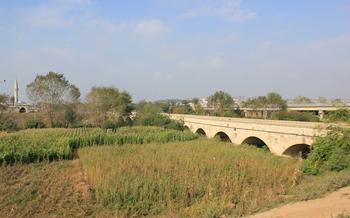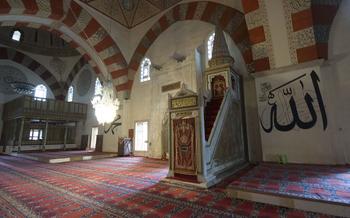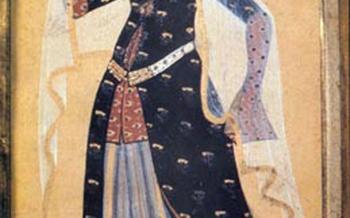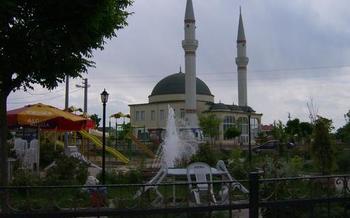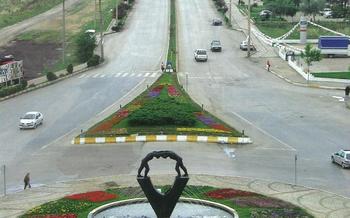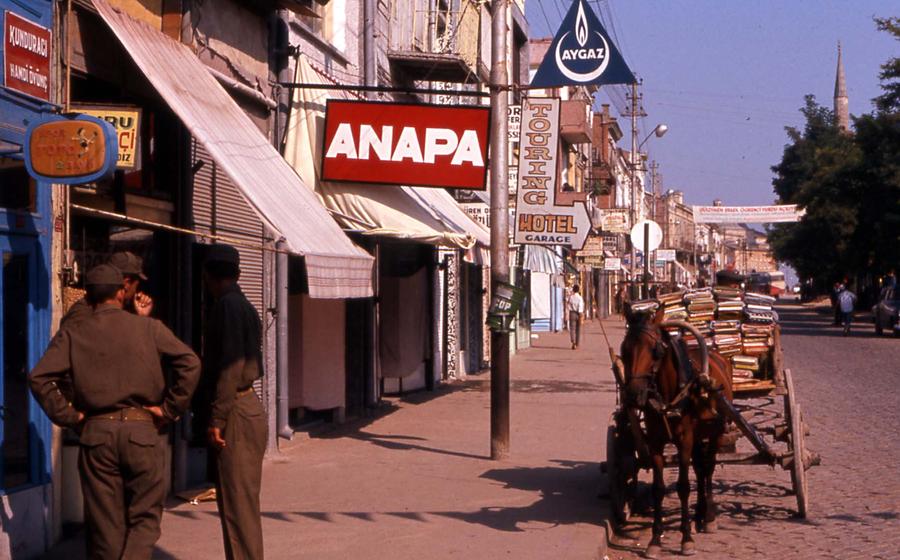
Telli Baba Tomb
- Telli Baba Tomb: An Overview
- Historical Context
- Architectural Marvel
- Inside the Tomb
- Spiritual Significance
- Historical Figures
- Restoration and Preservation
- Symbol of Unity
- Local Customs and Traditions
- Photography and Videography
- Local Cuisine and Restaurants
- Nearby Attractions
- Insider Tip: Unveiling the Hidden Chamber
Telli Baba Tomb: An Overview
Telli Baba Tomb, a significant historical and cultural landmark in Edirne, Turkey, holds immense importance in the city's heritage. Located in the heart of Edirne, the tomb is easily accessible to visitors. Its unique architectural features and intricate details make it a remarkable example of Ottoman-era architecture. According to local legends, Telli Baba, a revered Sufi saint, is believed to be buried in this tomb, adding to its spiritual significance. Visitors from all over the world come to pay their respects and seek blessings at this sacred site.
Historical Context
Edirne, a city steeped in history, was once the thriving capital of the Ottoman Empire during its golden age. The empire's influence permeated every corner of the city, leaving behind a legacy of magnificent architecture, cultural diversity, and influential figures. Among them, Telli Baba stands out as a revered Sufi saint and a prominent figure in Ottoman history.
Telli Baba's contributions to the development and prosperity of Edirne were significant. His spiritual guidance and teachings drew followers from across the empire, fostering a sense of unity and harmony among diverse communities. His influence extended beyond the realm of religion, as he actively participated in civic affairs, promoting education, trade, and infrastructure development.
Anecdotes and stories abound, highlighting Telli Baba's profound impact on the city. It is said that his blessings brought prosperity to merchants, his prayers averted calamities, and his wisdom settled disputes among the populace. His reputation as a miracle worker and a man of great piety spread far and wide, attracting pilgrims and visitors from distant lands.
Telli Baba's legacy continues to shape Edirne's identity. His tomb, a symbol of his enduring influence, stands as a testament to his contributions and the profound respect accorded to him by the people of Edirne and beyond.
Architectural Marvel
The Telli Baba Tomb stands as a testament to the architectural prowess and artistry of the Ottoman Empire. Its unique design and intricate details set it apart from other tombs of its era. The exterior of the tomb is adorned with exquisite tilework, featuring vibrant colors and geometric patterns that create a mesmerizing visual display. The domed structure, a prominent feature of Ottoman architecture, symbolizes the heavens and represents the tomb's spiritual significance.
The interior of the tomb is equally awe-inspiring, featuring a spacious main chamber adorned with intricate carvings and calligraphy. The mihrab, a niche indicating the direction of Mecca, and the minbar, a pulpit used for delivering sermons, are beautifully crafted and add to the spiritual atmosphere of the tomb. The tilework inside the tomb is particularly noteworthy, with vibrant blues, greens, and reds creating a harmonious and visually stunning effect.
The Telli Baba Tomb showcases a blend of Islamic and Ottoman architectural styles, reflecting the cultural and religious heritage of the region. Its unique design and intricate details make it a masterpiece of Ottoman architecture and a must-visit destination for anyone interested in Islamic art and history.
Inside the Tomb
Stepping inside the Telli Baba Tomb, visitors are greeted by a serene and awe-inspiring ambiance. The main chamber, with its domed ceiling, is adorned with intricate tilework and vibrant colors. The mihrab, a niche indicating the direction of Mecca, is a focal point of the tomb, adorned with intricate carvings and calligraphy. The minbar, a raised platform used for delivering sermons, is another notable feature, showcasing fine craftsmanship and attention to detail.
Artifacts and relics associated with Telli Baba and his life are carefully preserved within the tomb. Visitors can see personal belongings, manuscripts, and other items that offer a glimpse into his life and teachings. The tomb also houses a collection of antique carpets, each with unique patterns and colors, adding to the overall aesthetic and spiritual atmosphere of the space.
During my visit, I was particularly struck by the intricate tilework that adorned the walls and ceiling of the tomb. The vibrant blues, greens, and reds seemed to dance in the soft light, creating a mesmerizing effect. I spent a long time admiring the details of each tile, appreciating the artistry and craftsmanship that went into their creation.
The Telli Baba Tomb is not just a historical site but also a place of spiritual significance for many visitors. As I sat in the main chamber, I couldn't help but feel a sense of peace and tranquility wash over me. The atmosphere was conducive to contemplation and reflection, inviting visitors to connect with their inner selves and seek guidance and blessings from Telli Baba.
Spiritual Significance
Telli Baba's reputation as a Sufi saint and religious figure has made his tomb a significant pilgrimage site for both locals and visitors. The tomb is believed to possess spiritual energy and healing powers, attracting countless pilgrims who come to seek blessings, offer prayers, and pay their respects to the revered saint.
There are numerous anecdotes and stories of miraculous events and answered prayers associated with the tomb. Devotees often share tales of healing, guidance, and protection they have experienced after visiting the tomb and seeking Telli Baba's intercession. The tomb has become a symbol of faith, spirituality, and devotion, where people from all walks of life come to find solace, hope, and connection with the divine.
Historical Figures
Throughout history, numerous notable personalities and historical figures have been associated with the Telli Baba Tomb. One prominent figure is Sultan Murad II, who is believed to have visited the tomb on several occasions and held it in high regard. According to legend, the Sultan would often seek solace and guidance at the tomb, particularly during times of war or uncertainty.
Another notable figure is Evliya Çelebi, a renowned Ottoman traveler and writer who visited Edirne in the 17th century. In his travelogue, Çelebi provides a detailed account of the tomb, describing its architectural features and the miracles associated with Telli Baba. His writings have contributed to the tomb's fame and have attracted visitors from far and wide.
In addition to these historical figures, the tomb has also been visited by numerous Sufi masters and scholars over the centuries. These individuals have sought inspiration and guidance from Telli Baba's teachings, considering him a spiritual guide and a source of wisdom.
The associations with these prominent figures have further enhanced the significance of the Telli Baba Tomb, making it a place of reverence and pilgrimage for people from all walks of life.
Restoration and Preservation
Telli Baba Tomb has undergone several restoration and preservation efforts over the years to maintain its historical integrity and significance. The tomb's exterior and interior have been carefully restored, preserving the intricate details and decorations that adorn its facade and walls. Skilled artisans and craftsmen employed traditional techniques to ensure the authenticity and longevity of the restoration work.
One of the key challenges faced during the restoration process was the need to balance preservation with modernization. While preserving the tomb's original features, modern amenities such as lighting and ventilation systems were discreetly incorporated to enhance the visitor experience without compromising the historical ambiance.
Preserving Telli Baba Tomb is a collaborative effort involving local authorities, organizations, and the community. These stakeholders work together to safeguard the tomb from deterioration and vandalism, ensuring that future generations can continue to appreciate its cultural and historical significance. The tomb's preservation is not only a testament to its enduring legacy but also a symbol of respect for the past and a commitment to the future.
Symbol of Unity
Telli Baba Tomb stands as a testament to the rich cultural heritage and diversity that Edirne embraces. Over the centuries, the tomb has become a symbol of unity and harmony among different cultures and religions. People from all walks of life, regardless of their beliefs or backgrounds, come together to pay their respects and seek blessings at the tomb.
Stories abound of individuals from different faiths visiting the tomb together, offering prayers and seeking guidance. The tomb's aura of spirituality and reverence transcends religious boundaries, creating a space for interfaith dialogue and understanding.
One remarkable anecdote is the story of a group of Christian pilgrims who traveled to Edirne specifically to visit the tomb. They were warmly welcomed by the local Muslim community, who facilitated their visit and even arranged for a special prayer session. The pilgrims were deeply moved by the hospitality and respect they received, and they left Edirne feeling a sense of unity and brotherhood.
The Telli Baba Tomb is a living example of how faith can bring people together, fostering coexistence and mutual respect. It serves as a reminder that despite our differences, we share a common humanity and a desire for peace and harmony.
Local Customs and Traditions
The Telli Baba Tomb is not only a historical and architectural marvel but also a place deeply intertwined with local customs and traditions. Visitors can witness unique rituals and practices performed by pilgrims and locals alike. One of the most prominent customs is tying a wish to the tomb's railings. Devotees write their wishes on small pieces of paper or cloth and tie them to the railings, believing that Telli Baba will intercede on their behalf and fulfill their desires.
Another tradition associated with the tomb is the distribution of food and drinks. Visitors often bring offerings of food, such as bread, pastries, or sweets, to share with others. This act of generosity is believed to bring blessings and good fortune.
During special occasions and religious holidays, the tomb becomes a hub of cultural activities. Traditional music performances, Sufi chanting, and devotional ceremonies fill the air, creating a mesmerizing atmosphere. These events provide a glimpse into the rich spiritual heritage of Edirne and the devotion to Telli Baba among the local community.
Observing these customs and traditions offers a unique opportunity to connect with the local culture and gain a deeper understanding of the tomb's significance beyond its historical and architectural value. Visitors are encouraged to respectfully participate in these practices, showing appreciation for the local customs and traditions that have been passed down through generations.
Photography and Videography
The Telli Baba Tomb offers ample opportunities for capturing stunning photographs and videos. To make the most of your visual journey, consider these tips:
-
Best Angles and Lighting: The tomb's exterior is particularly photogenic in the warm glow of the morning or evening light. For interior shots, natural light filtering through the windows creates a beautiful, diffused effect.
-
Experiment with Perspectives: Don't be afraid to experiment with different angles and perspectives. Try capturing the tomb's grandeur from a low angle or showcasing its intricate details with close-up shots.
-
Respectful Photography: Remember to be respectful of the tomb's sacred nature. Avoid using flash photography or making noise that may disturb other visitors.
-
Create a Visual Narrative: If you're creating a video, consider crafting a narrative that weaves together the tomb's history, architecture, and spiritual significance. This will help viewers connect with the tomb on a deeper level.
Local Cuisine and Restaurants
A visit to the Telli Baba Tomb is not complete without savoring the delectable flavors of Edirne's local cuisine. In the vicinity of the tomb, you'll find an array of restaurants and cafes that offer an authentic culinary experience.
For a taste of traditional Turkish cuisine, head to one of the many "köfte" restaurants, where you can indulge in succulent meatballs grilled to perfection and served with tantalizing dips and sauces. Pair your meal with a refreshing glass of "ayran," a yogurt-based beverage that perfectly complements the savory flavors.
If you're craving something sweet, be sure to try "tel kadayıf," a delicate pastry made from thin strands of dough filled with chopped walnuts and drenched in sweet syrup. This heavenly dessert is a local specialty that you won't want to miss.
For a more upscale dining experience, I highly recommend trying one of the many fish restaurants along the Tunca River. The freshly caught fish, grilled or fried to perfection, is a true delight. Accompany your meal with a glass of local wine or "raki," a traditional Turkish spirit, for a truly memorable culinary adventure.
Insider tip: For a taste of authentic Turkish coffee, visit one of the many "kahvehane" (coffeehouses) near the tomb. These traditional establishments offer a unique atmosphere where you can sip on your coffee and engage in lively conversations with the locals.
Nearby Attractions
In addition to the Telli Baba Tomb, Edirne offers a wealth of historical sites, museums, and attractions that are worth exploring. Visitors can embark on a captivating walking route that begins at the tomb and leads them through the heart of the city's rich past. The route takes you past the iconic Selimiye Mosque, a masterpiece of Ottoman architecture, where you can marvel at its soaring domes and intricate tilework. Continue your journey to the Edirne Archaeological and Ethnographic Museum, which houses a fascinating collection of artifacts that provide a glimpse into the city's diverse history. Don't miss the opportunity to visit the Great Synagogue of Edirne, one of the oldest and largest synagogues in Europe, showcasing the city's vibrant Jewish heritage. As you wander through the charming cobbled streets, keep an eye out for hidden gems like the Bedesten, a covered market dating back to the Ottoman era, where you can find unique souvenirs and local handicrafts.
Insider Tip: Unveiling the Hidden Chamber
Beyond the main chamber of the Telli Baba Tomb lies a hidden secret, a concealed chamber that few visitors are aware of. This enigmatic space, tucked away from the main thoroughfare, is believed to have served as a meditation room for Telli Baba himself. Its walls are adorned with intricate Sufi calligraphy and verses from the Quran, creating an atmosphere of profound spirituality. Access to this hidden chamber is granted only to those who seek a deeper connection with the saint and his teachings. If you happen to befriend a local guide or caretaker of the tomb, they may be willing to reveal the secrets of this hidden chamber and allow you to experience its sacred ambiance.
